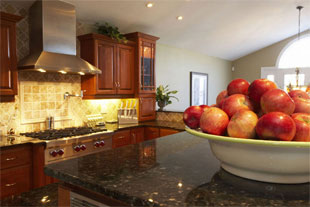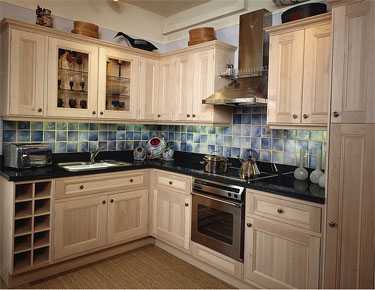Atlanta, GA
404-872-0024
404-872-0024
Alpharetta, GA
770-475-4496
770-475-4496
Charlotte / Raleigh, NC
980-819-5515
980-819-5515
Nashville, TN
615-771-7477
615-771-7477
Charleston, SC
843-856-8255
843-856-8255
Countertops & Wall Tile - Backsplashes
Backsplashes do more than just protect the walls from grease and cooking splatter. Backsplashes are a wonderful way to jazz up your kitchen with an element of style that reflects your personality.
Considerations:

- Generally, you have about 18.5” to work with from the top of the countertop to the bottom of the cabinets.
- Sometimes, behind a cooking surface you will have more room to tile between the countertop and the hood or microwave
- You can tile from the countertop to the bottom of the top cabinets or from the 4” or 6” backsplash that matches the countertop. Keep in mind, this limits your space to tile to approximately 12-14”. This can be helpful or not so helpful depending on the size of your tile.
- If you choose a decorative pattern for your tile, remember items like pot fillers that can end up right in the middle of your decorative pattern!
- Choosing to mix different tiles to create a pattern in encouraged, but be careful about mixing tiles with different thicknesses. Check with your tile designer or tile setter to see if your choices will work together for a smooth installation.
- Textured tiles or 3 dimensional tiles with patterned reliefs are beautiful – if you are not the person that has to clean them!
Options:
- Finishing the tile – be sure to find out if the tile you select has a coordinating bullnose to finish off the edges of the last piece of tile.
- If your upper wall cabinets do not end on the same line as your base cabinets and countertop, be sure to clearly choose a stopping point for the tile.
- Using a sealer for your grout to help staining
- If you choose not to seal your grout, be sure to choose a color that will hide kitchen stains the most.
Backsplashes can be made from the following materials:
- The same material as the countertop, i.e. tile, granite, solid surface, etc. either 4” or 6” high or from the countertop to the bottom of the cabinets. Not very exciting, but practical.
- With some surfaces like solid surface countertops the transition from the countertop to the backsplash can be seamless. This is helpful from a maintenance standpoint.
- Granite, marble or other natural stone tiles
- Ceramic or porcelain tile
- Mosaic tiles
Decorative Design Options:

- Set the tile square or straight lay with no added options
- Set the tile at a 45 degree angle or on the diagonal
- Set the tile with a brick joint or running bond pattern
- Add a decorative listello at the top, bottom or both (straight or diagonal lay)
- Clip the corners of the tiles turned on the diagonal and insert a decorative “dot’ made from tile, metal, glass or stone. This works best with a 4” or 6” tile
- Alternate colors to make a checkerboard pattern
- Mix some of the elements above and set the tile straight, but turn one row in the center on the diagonal. This can be outlined with a listello at the top and the bottom of the diagonal band if you have room or a decorative dot can be inserted in between the diagonal tiles.
- If you have a large enough area behind the cooking surface, add a feature like a decorative picture frame. This can be created with a listello as the frame and it gives you the option of the choices listed above to accent the interior.
- Solid mosaic backsplashes can be a timeless choice with an element of “punch” that will be great for you and good for resale as well.

